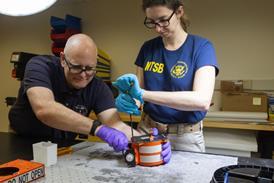NASA's Deep Space 1 New Millennium programme spacecraft has passed a major milestone in ion propulsion system development, accumulating more operating time in space than any other powerplant system in the history of the space programme, according to NASA's Jet Propulsion Laboratory (JPL).
The spacecraft, launched in October 1998, has already operated its ion propulsion system for more than 200 days.

Ion propulsion systems have previously not been used as the main engines, but only to keep a satellite on track. Deep Space 1 is the first spacecraft to use this technology as primary propulsion. NASA's Space Electric RocketTest 2, launched into Earth orbit in 1970, previously held the record for ion propulsion, thrusting for about 161 days.
Ion propulsion systems are more efficient than traditional chemical rockets using solid or liquid fuels. Although ion propulsion engines are slow to pick up speed, over a long period they can deliver 10 times more thrust per pound of fuel than traditional rockets.
The technology only consumes about 100g of xenon per day, taking about four days to use just 0.4kg (1lb). As an ion propulsion system uses little propellant and weighs less than other fuels, it can use a less expensive launch vehicle and ultimately go much faster than other spacecraft.
The system emits a blue glow as ionized, electrically charged xenon atoms are pushed out of the engine. The ion particles are emitted from the system at about 11,000km/h (68,000mph). However, Deep Space 1 does not move that fast in the other direction because it is much heavier than the ion particles. The Deep Space 1 ion engine could have a total operating time of more than 583 days (14,000h) by the end of its mission in late 2001.
The only system that has operated longer than Deep Space 1's propulsion system is a ground-based replica, which has run in a vacuum test chamber at JPL for almost 500 days or 12,000h and will complete nearly 625 days or 15,000h of operation by the end of the year.
With its primary mission as a technology demonstrator - testing ion propulsion and 11 other advanced technologies - successfully completed in September last year, Deep Space 1 is now on its way for a rendezvous with the Comet Borrelly scheduled for September 2001.
Source: Flight International























